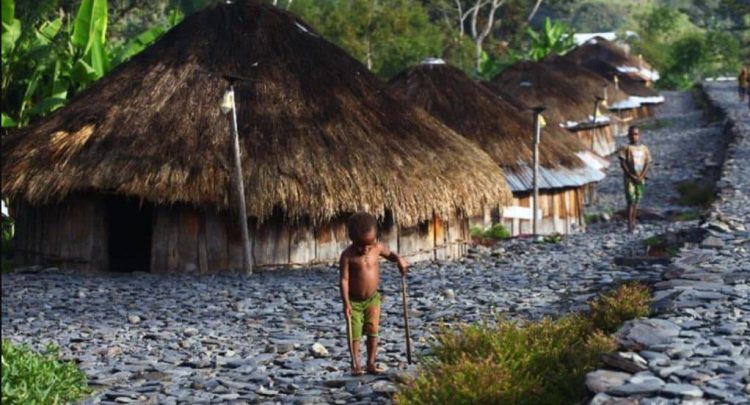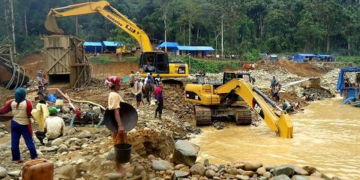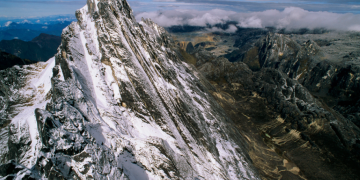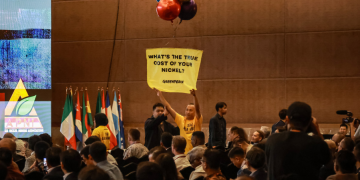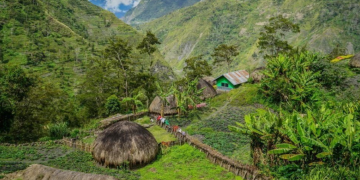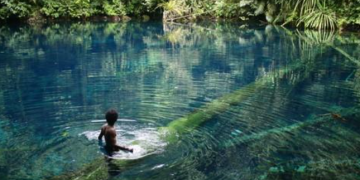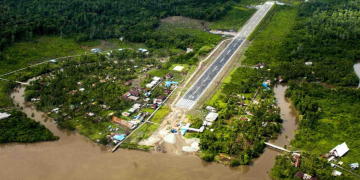PAPUAAROUND – Honai house is one of the traditional houses originating from Papua. Honai is often also called Onai by the local community.
Quoting the Indonesia.go.id page, Honai houses can be found in the valleys and mountains in the middle of Papua Island. Generally, Honai houses are at an altitude of 1,600-1,700 meters above sea level (masl).
Honai is a tiny house that has a mushroom-like shape. The base is circular and the roof is cone-shaped made of thatch.
The shape of the conical roof that covers the bottom aims to protect the entire surface of the walls from being exposed to rainwater. In addition, it is also useful so that people who are in it are not cold.
The Origins of the Honai Traditional House
The Honai Traditional House was born from the culture of the Dani tribe. The Dani people live in areas in the valleys and mountains of central Papua
Quoting a book entitled Round House by Fangnania T. Rumthe on the website of the Ministry of Education and Culture, the Dani people used to live under big trees. When night time comes, they will feel cold.
Especially when it rains, they will get wet in the rain. This is because the leaves on the trees where they live cannot continuously withstand the pouring rain, especially when the wind is blowing hard.
Then one day, the Dani people, who depend on nature, then study with the birds around them. They watched the birds making nests. The bird will make a nest when it is about to lay eggs.
They saw male and female birds flying here and there to collect some sticks and dry grass. These materials are then formed into a round nest and a warm place to live for the newborn chicks.
The Dani people have finally learned how to build houses that can protect them from hot, cold and rainy weather. Then the house was known as Honai, or Onai. In the local language, Onai means house.
The honai that was built by the Dani people is round or circular in shape, just like a bird’s nest, as well as the semi-circular roof. There is no Honai that is not round.
Types of Honai Traditional Houses
Honai Traditional House consists of several types, there are Honai Men and Honai Women. Each of these types of Honai has a different function.
Honai Men is Honai which is a bed for adult men and those who are growing up. This honai is larger in shape and is used to store traditional symbols.
Apart from that, Honai Men are also used for group meetings or receiving guests. Therefore, Honai Men generally have a larger size.
Meanwhile, Honai Perempuan is a bed for mothers and small children. Then, there is also a place that is used as a kitchen. Rectangular shape.
Sometimes the kitchen is used as a bed by the Dani people. The reason is that the place feels warm because there is cooking activity using wood fire in the stove.
Once warm enough, the fire will be extinguished. Then only the smoke inside the Honai can warm the body until morning.
Lighting in Honai is enough with a burning fire. They rarely use candles because of the risk of fire.
The Honai that was built had only one door and no windows. Therefore, people who live in Honai will more easily suffer from respiratory ailments.
Honai Current
Along with the development of the times and public awareness, some Honai already have windows for ventilation. Some even make Honai out of bricks because wood and reeds don’t last long.
Meanwhile, people who have more income have started building houses. The house is not round like Honai, but is rectangular and they call it a long house.
The house has bedrooms, doors and windows. As for the walls, they are still made of boards, and the roof uses corrugated iron.
As said earlier, this house was built by people who have more income because the costs are not small. This is because the raw materials used come from the city and are quite difficult to bring to the construction site because of the steep terrain.
The process of making a traditional Honai house
The process of making a Honai Traditional House is quite easy, here are the ingredients and the steps for making it.
Ingredients
The following are the materials needed to make Honai. All ingredients are taken from nature.
– Chopped boards, called chopped boards because the two ends of the boards are pointed like spears. The pointy end of the board will be planted into the ground. Chopped boards are used as the walls of the Honai.
– Wooden beams for the center pillar or the main pillar. The main pillar serves to support the roof of the Honai
– Fruit wood for the framework of the Honai roof cover
– Lokop/Pinde is shaped like a small long bamboo which functions as a bed base
– Reeds as the roof of the Honai
– Rattan rope, derived from tree roots, or vines that function like ropes
Making process
In the custom of the Dani people, if a family wants to make a Honai, they will invite their relatives or family. During the process of building the Honai, they will eat together which is called stone fuel.
First, they would dig up the ground and then place a large, flat stone as the base for the base. After that, the main pillar was placed on top of the boulder.
The goal, so that the main pillar is not quickly weathered due to water infiltration. Then the pole is placed at the midpoint of the Honai.
Furthermore, around the pole dug earth in the shape of a circle. Chopped boards with sharp ends are stuck or planted following the circle that has been dug.
The distance between the main pole and the chopped board is adjusted to the area of the Honai you want to make. Then each board that is planted, must be tied with rattan rope so that the wall of the board can stand firmly.
The Dani people are most skilled at forming Honai circles without using calipers or special tools. That said, it is an ability that comes from the heart.
After the pillars and walls of the Honai stand, then the roof frame is installed by tying the fruit wood to the main pillars and walls of the Honai. Then the fruit wood is arranged in a circle like an umbrella on top of the Honai.
Next, the reeds are collected and then tied up like tying a broom stick to be attached to the roof. Then the roof is tied to the roof frame using rattan rope. To prevent it from rotting quickly, the thatch roof is smoked.
For the base, the Dani people weave lokop/pinde to make a mat as a bed. Lokop/pinde is the regional language for a plant that resembles rattan because it is flexible, but hollow inside like bamboo.
Furthermore, the Dani people make a fire in the Honai. The fire stove functions as a heater as well as to burn the sweet potatoes.
Meanwhile, to prevent rainwater from entering the Honai, they made drains around the Honai. This Honai Traditional House can be used for 4-5 years.
Also Read: Seeing the Beauty of West Papua Tourism Nature in Manokwari, From Doreri Bay to White Sand Beach

